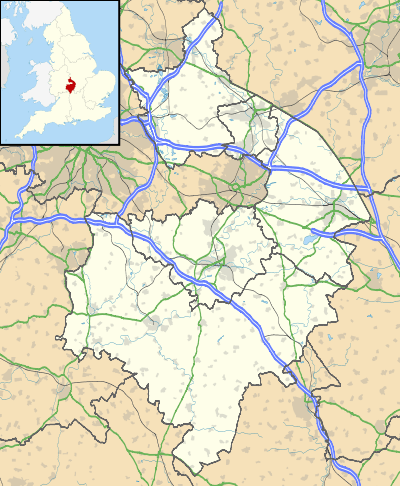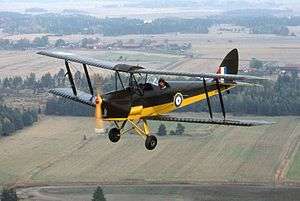RAF Ansty
Royal Air Force Ansty or RAF Ansty is a former Royal Air Force station located 5.0 miles (8.0 km) east of Coventry city centre, Warwickshire, England, 7.0 miles (11.3 km) north-west of Rugby, Warwickshire. The airfield was opened in 1936 and after training many pupils closed in 1953.[1]
RAF Ansty | |||||||||||||||
|---|---|---|---|---|---|---|---|---|---|---|---|---|---|---|---|
| Summary | |||||||||||||||
| Airport type | Military | ||||||||||||||
| Owner | Air Ministry | ||||||||||||||
| Operator | Royal Air Force | ||||||||||||||
| Location | Ansty, Warwickshire | ||||||||||||||
| Built | 1935 | ||||||||||||||
| In use | 1936-1953 | ||||||||||||||
| Elevation AMSL | 381 ft / 116 m | ||||||||||||||
| Coordinates | 52°25′45″N 001°24′31″W | ||||||||||||||
| Map | |||||||||||||||
 RAF Ansty Location in Warwickshire | |||||||||||||||
| Runways | |||||||||||||||
| |||||||||||||||
Station history

The airfield was mainly used for schools with taught navigation and flying to new recruits using a varied range of aircraft such as de Havilland Tiger Moths and Avro Ansons. The first school teaching navigation to arrive was No. 4 Civilian Air Navigation School RAF with the Anson between September 1938 and October 1939 before being renamed No. 4 Air Observer Navigation School RAF (AONS) using Blackburn Bothas as an additional aircraft type between September 1939 and July 1940 before moving to another airfield.[2]
The other schools were used for flying training with the first school arriving on 6 January 1936 which was the No. 9 Elementary and Reserve Flying Training School RAF which flew Ansons, Hawker Harts, Hawker Hinds, Tiger Moths and Clouds until 3 September 1939. The school was operated by Air Services Training at RAF Hamble, under contract from the Air Ministry. The school was renamed the No. 9 Elementary Flying Training School RAF on 3 September 1939 days after the Second World War broke out. The school used Moths until 31 March 1944 which provided initial assessment before pupil pilots were sent abroad in the British Commonwealth Air Training Plan which was operated by Air Service Training.[2]
A number of maintenance units used the site for a small amount of time like when a sub site of No. 27 Maintenance Unit RAF joined in October 1940 and No. 48 MU which used the airfield for temporary dispersal between 1940 and February 1941. After the Second World War the airfield hosted No. 2 Basic Flying Training School RAF from 21 March 1951 until 31 March 1953.[2]
The Coventry Blitz
The first bombs of the war dropped in the vicinity of Coventry were when five dropped on RAF Ansty on 25 June 1940. There were no casualties. This was two days before any civilians were killed near Coventry, when the Hillfields area was bombed and 16 people lost their lives.[3]
Accidents and incidents
During life as a RAF training base accidents were not far away with a number of airmen killed during training.
| Date | Incident | Reference |
|---|---|---|
| February 1940 | During WW2 aircraft maintenance units tried using this airfield for storage purposes but apparently it was often water-logged. There is a story that six Blackburn Botha types flown in to Ansty from Hawarden in February 1940 may have sunk in so deep they were never rescued. | [4] |
| 5 March 1941 | A Tiger Moth of 9 EFTS was landing when it collided with another Tiger Moth on the ground. Both were burnt out, but there were no casualties. | [5] |
| 14 May 1941 | Tiger Moths N5456 and N5472 of 9 EFTS are recorded as crashing. | [5] |
| 8 July 1941 | Tiger Moth N6649 of 9 EFTS hit a bus on approach. | [5] |
| 1 August 1941 | A pair of Tiger Moths from 9 EFTS collided in the air at Whitley. | [5] |
| 16 February 1942 | A pair of Tiger Moths from 9 EFTS collided near the airfield | [6] |
| 29 May 1943 | Tiger Moth R4921 of 9 EFTS crashed near the airfield after engine failure. | [7] |
Current use
Rolls-Royce currently occupies the majority of the site as an engine overhaul and repair facility. The company recently won a contract overhauling the EJ2000 engine, which is used in the Eurofighter Typhoon with some of the work being performed at Ansty, which will also help to keep 3,000 jobs for the company throughout the country.[8][9][10]
The northern side has been turned into a business park called Ansty Park, companies on the site include AVL, MTC, Sainsburys, London Taxi Company, HTRC and Fanuc Robotics.[1]
References
- "Ansty (Coventry)". Airfields of Britain Conservation Trust. Retrieved 11 April 2012.
- "Military flying units in the south west Midlands". Aviation Archaeology. Retrieved 11 April 2012.
- "Coventry's Blitz". Historic Coventry. Retrieved 11 April 2012.
- "UK Airfields & Airports". Retrieved 17 May 2017.
- "Military aircraft crashes in the south west Midlands - 1941". Aviation Archaeology. Retrieved 11 April 2012.
- "Military aircraft crashes in the south west Midlands - 1942". Aviation Archaeology. Retrieved 11 April 2012.
- "Military aircraft crashes in the south west Midlands - 1943". Aviation Archaeology. Retrieved 11 April 2012.
- "£865m Engine contract for RAF's fastest jets". Evaint. Retrieved 12 April 2012.
- "RAF £865m Jet Investment". 4 Northern Ireland. Retrieved 12 April 2012.
- "New engine support contract for RAF Typhoons". Key Aero Publishing. Archived from the original on 3 August 2012. Retrieved 12 April 2012.
External links
- Historic Coventry - Blitz
- Scottish Saltire Aircrew Association - Combatting Stress - Then and Now
- BBC History WW2 People's War - Henry Kaye, Flying Instructor by Ron Goldstein
- 213 Squadron Association - Second World War 1937 - 1945
- Rugby Counical - Planning Portal - Ansty Park
- BBC History - Flt. Lieut. John Anderson - Who knows what the future holds?
- William Budd’s time in the RAF
